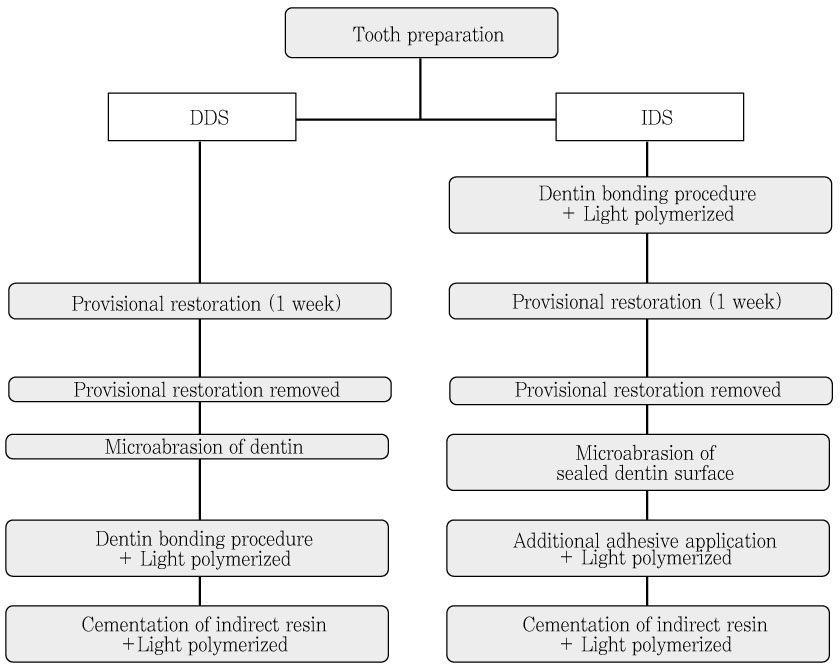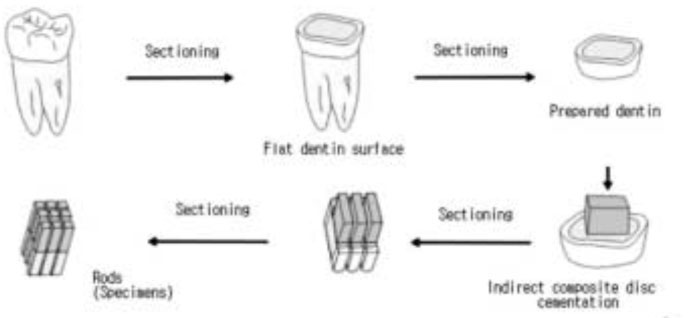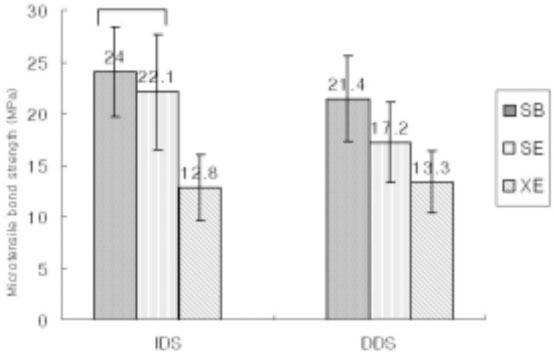J Korean Acad Conserv Dent.
2008 Nov;33(6):526-536. 10.5395/JKACD.2008.33.6.526.
The effect of various bonding systems on the microtensile bond strength of immediate and delayed dentin sealing
- Affiliations
-
- 1Department of Conservative Dentistry, School of dentistry, Pusan National University, Korea. jeongkil@pusan.ac.kr
- KMID: 1428463
- DOI: http://doi.org/10.5395/JKACD.2008.33.6.526
Abstract
- The purpose of this study was to compare the effect of various dentin bonding systems on microtensile bond strength of immediate dentin sealing (IDS) and delayed dentin sealing (DDS). Eighteen extracted permanent molars were used in this study. The teeth for DDS group were restored with a provisional restorations, and immersed in saline solution for 1 week, and divided into 3 subgroups according to various dentin bonding adhesives; SB subgroup (3 step total-etch adhesive), SE subgroup (2 step self-etch adhesive), XE subgroup (1 step self-etch adhesive). In IDS group, the teeth were divided into 3 subgroups, and applied with bonding adhesives as in DDS group. The teeth were restored with provisional restorations, and immersed in saline solution for 1 week. Indirect composite disc was cemented with resin cement, and all specimens were subjected to microtensile bond strength. The data were statistically analyzed with one-way ANOVA and Student t-test. The results were as follows: 1. The IDS group showed significantly higher microTBS than DDS group in 3 step total-etch and 2 step self-etch adhesive (p < 0.05). 2. In IDS and DDS group, 3 step total-etch adhesive showed the highest microTBS value, followed by 2 step self-etch, and 1 step self-etch adhesive. In IDS group, the microTBS value for 1 step self-etch adhesive was significantly different from those of the other subgroups (p < 0.05), and in DDS group, there were statistical differences in all subgroup (p < 0.05). 3. Failure modes of tested dentin bonding adhesives were mostly mixed failure and only 1 step self-etch adhesive showed adhesive failure.
Keyword
MeSH Terms
Figure
Cited by 1 articles
-
The effect of Er,Cr:YSGG irradiation on microtensile bond strength of composite resin restoration
Jeong-Hye Son, Hyeon-Cheol Kim, Bock Hur, Jeong-Kil Park
J Korean Acad Conserv Dent. 2010;35(2):134-142. doi: 10.5395/JKACD.2010.35.2.134.
Reference
-
1. Stavridakis MM, Krejci I, Magne P. Immediate dentin sealing of onlay preparations: thickness of pre-cured Dentin Bonding Agent and effect of surface cleaning. Oper Dent. 2005. 30:747–757.2. Dietschi D, Magne P, Holz J. Recent trends in esthetic restorations for posterior teeth. Quintessence Int. 1994. 25:659–677.3. Touati B, Aidan N. Second generation laboratory composite resins for indirect restorations. J Esthet Dent. 1997. 9:108–118.
Article4. Magne P. Immediate dentin sealing: a fundamental procedure for indirect bonded restorations. J Esthet Restor Dent. 2005. 17:144–154.
Article5. Paul SJ, Scharer P. The dual bonding technique: a modified method to improve adhesive luting procedures. Int J Periodontics Restorative Dent. 1997. 17:536–545.6. Bertschinger C, Paul SJ, Luthy H, Scharer P. Dual application of dentin bonding agents: effect on bond strength. Am J Dent. 1996. 9:115–119.7. Magne P, Douglas WH. Porcelain veneers: dentin bonding optimization and biomimetic recovery of the crown. Int J Prosthodont. 1999. 12:111–121.8. Van Meerbeek B, De Munck J, Yoshida Y, Inoue S, Vargas M, Vijay P, Van Landuyt K, Lambrechts P, Vanherle G. Buonocore memorial lecture. Adhesion to enamel and dentin: current status and future challenges. Oper Dent. 2003. 28:215–235.9. Yeşilyurt C, Bulucu B. Bond strength of total-etch and self-etch dentin adhesive systems on peripheral and central dentinal tissue: a microtensile bond strength test. J Contemp Dent Pract. 2006. 7:26–36.
Article10. Prati C, Chersoni S, Mongiorgi R, Pashley DH. Resin-infiltrated dentin layer formation of new bonding systems. Oper Dent. 1998. 23:185–194.11. Van Meerbeek B, Van Landuyt K, De Munck J, Hashimoto M, Peumans M, Lambrechts P, Yoshida Y, Inoue S, Suzuki K. Technique-sensitivity of contemporary adhesives. Dent Mater J. 2005. 24:1–13.
Article12. De Munck J, Van Meerbeek B, Satoshi I, Vargas M, Yoshida Y, Armstrong S, Lambrechts P, Vanherle G. Microtensile bond strengths of one- and two-step self-etch adhesives to bur-cut enamel and dentin. Am J Dent. 2003. 16:414–420.13. Park JS, Kim JS, Kim MS, Son HH, Kwon HC, Cho BH. Aging effect on the microtensile bond strength of self-etching adhesives. J Korean Acad Conserv Dent. 2006. 31:415–426.
Article14. Tay FR, Pashley DH, King NM, Carvalho RM, Tsai J, Lai SC, Marquezini L Jr. Aggressiveness of self-etch adhesives on unground enamel. Oper Dent. 2004. 29:309–316.15. Dietschi D, Monasevic M, Krejci I, Davidson C. Marginal and internal adaptation of class II restorations after immediate or delayed composite placement. J Dent. 2002. 30:259–269.
Article16. Nagaoka S, Miyazaki Y, Liu HJ, Iwamoto Y, Kitano M, Kawagoe M. Bacterial invasion into dentinal tubules of human vital and nonvital teeth. J Endod. 1995. 21:70–73.
Article17. Suzuki S, Cox CF, White KC. Pulpal response after complete crown preparation, dentinal sealing, and provisional restoration. Quintessence Int. 1994. 25:477–485.
Article18. Courson F, Bouter D, Ruse ND, Degrange M. Bond strengths of nine current dentine adhesive systems to primary and permanent teeth. J Oral Rehabil. 2005. 32:296–303.
Article19. Bouillaguet S, Gysi P, Wataha JC, Ciucchi B, Cattani M, Godin C, Meyer JM. Bond strength of composite to dentin using conventional, one-step, and self-etching adhesive systems. J Dent. 2001. 29:55–61.
Article20. Rontani RM, Ducatti CH, Garcia-Godoy F, De Goes MF. Effect of etching agent on dentinal adhesive interface in primary teeth. J Clin Pediatr Dent. 2000. 24:205–209.21. Tanumiharja M, Burrow MF, Tyas MJ. Microtensile bond strengths of seven dentin adhesive systems. Dent Mater. 2000. 16:180–187.
Article22. Randall RC, Wilson NH. Glass-ionomer restoratives: a systematic review of a secondary caries treatment effect. J Dent Res. 1999. 78:628–637.
Article23. Armstrong SR, Vargas MA, Fang Q, Laffoon JE. Microtensile bond strength of a total-etch 3-step, total-etch 2-step, self-etch 2-step, and a self-etch 1-step dentin bonding system through 15-month water storage. J Adhes Dent. 2003. 5:47–56.24. Pashley EL, Agee KA, Pashley DH, Tay FR. Effects of one versus two applications of an unfilled, all-in-one adhesive on dentine bonding. J Dent. 2002. 30:83–90.
Article25. Park JG, Cho KH, Cho YG. Effects of application methods of a self-etching primer adhesive system on enamel bond strength. J Korean Acad Conserv Dent. 2008. 33:90–97.
Article26. Opdam NJ, Roeters FJ, Feilzer AJ, Verdonschot EH. Marginal integrity and postoperative sensitivity in Class 2 resin composite restorations in vivo. J Dent. 1998. 26:555–562.
Article27. Nishiyama N, Suzuki K, Yoshida H, Teshima H, Nemoto K. Hydrolytic stability of methacrylamide in acidic aqueous solution. Biomaterials. 2004. 25:965–969.
Article28. Tay FR, Pashley DH, Yoshiyama M. Two modes of nanoleakage expression in single-step adhesives. J Dent Res. 2002. 81:472–476.
Article29. Son CY, Kim HC, Hur B, Park JK. Effects of one or two applications of all-in-one adhesive on microtensile bond strength to unground enamel. J Korean Acad Conserv Dent. 2006. 31:445–451.
Article30. Inoue S, Vargas MA, Abe Y, Yoshida Y, Lambrechts P, Vanherle G, Sano H, Van Meerbeek B. Microtensile bond strength of eleven contemporary adhesives to dentin. J Adhes Dent. 2001. 3:237–245.31. Tay FR, Carvalho R, Sano H, Pashley DH. Effect of smear layers on the bonding of a self-etching primer to dentin. J Adhes Dent. 2000. 2:99–116.
- Full Text Links
- Actions
-
Cited
- CITED
-
- Close
- Share
- Similar articles
-
- The comparison of microtensile bond strength with immediate and delayed dentin sealing
- Influence of air abrasion and different dentin sealing techniques on microtensile bond strength to dentin
- Microtensile bond strength of resin inlay bonded to dentin treated with various temporary filling materials
- An effect of immediate dentin sealing on the shear bond strength of resin cement to porcelain restoration
- Effect of moisture and drying time on the bond strength of the one-step self-etching adhesive system






